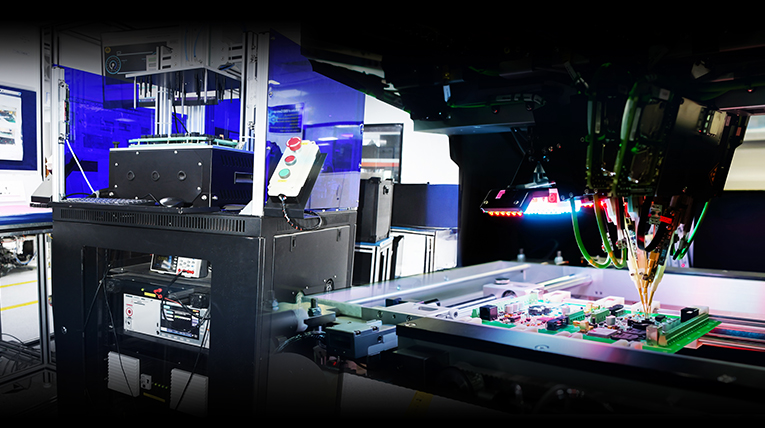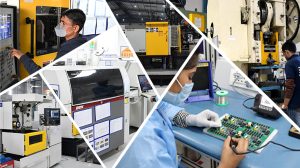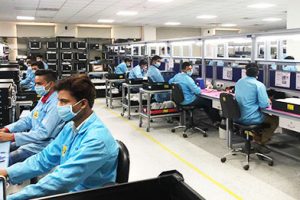In today’s electronics manufacturing landscape, ensuring high product quality, reducing human error and meeting demanding time-to-market goals are more important than ever. This is where Automated Test Equipment (ATE) comes into play — serving as a critical enabler for reliable, fast and repeatable product validation.
In this blog, we will dive deep into what ATE is, its core components, real-world applications and how it transforms modern production lines. We’ll also explore how VVDN helps OEMs and EMS providers design, develop and deploy robust ATE solutions that enhance test coverage, reduce field failures and maximize production efficiency.
Table of Contents
What is Automated Test Equipment (ATE)?
Automated Test Equipment refers to a system of hardware and software designed to automatically perform tests on electronic devices to ensure their functionality, performance and quality. These systems are crucial for minimizing manual intervention, ensuring accuracy and enabling high-speed validation in manufacturing environments.
ATE systems are typically used to test semiconductors, circuit boards, embedded systems, power electronics, communication devices and fully assembled products across various sectors—from automotive to consumer electronics.
Why ATE is Essential in Modern Manufacturing?
Manual testing in high-volume production is prone to human error, inefficiency, and inconsistency. ATE addresses these challenges by offering:
- Speed: High-throughput testing keeps pace with demanding production lines.
- Accuracy: Automated measurements reduce errors and false positives.
- Repeatability: Identical conditions and procedures across test cycles ensure consistent results.
- Cost Efficiency: Reduced labor and faster test cycles lower the cost per unit tested.
- Scalability: Easily adaptable to different product lines and test cases.
Key Components of ATE Systems
A well-structured ATE system typically consists of the following components:
- Test Fixtures & Probes: Custom mechanical interfaces to connect the Device Under Test (DUT).
- Instrumentation: Tools like oscilloscopes, multimeters, signal generators, power supplies or spectrum analyzers.
- Control Hardware: Microcontrollers, FPGAs, or industrial PCs for test sequence control and data acquisition.
- Software Interface: Test automation software for scripting, execution, data logging and reporting.
- Safety & Monitoring: Cut-off systems, environmental sensors and diagnostic logging for safety and traceability.
Real-World Applications of ATE
ATE systems are used across industries and support a wide range of test categories:
1. Functional Testing
- Ensures a product performs according to specifications under normal and extreme operating conditions.
2. In-Circuit Testing (ICT)
- Checks the integrity of individual components and connections on a PCB.
3. RF and Wireless Testing
- Verifies performance of devices with Wi-Fi, Bluetooth, BLE, Zigbee and other RF communication protocols.
4. Optical & Camera Testing
- Emulates various lighting environments and object distances to assess image acquisition and processing.
5. Power and Battery Validation
- Confirms voltage levels, load handling and safety protection features in power electronics and energy storage devices.
6. Audio/Video Testing
- Assesses output quality, distortion levels, and compliance with performance standards.
7. Burn-in and Reliability Testing
- Subjects devices to extended operation at elevated temperatures to detect early-life failures.
8. End-of-Line (EOL) Testing
- Performed at the final stage of production, EOL testing ensures that the fully assembled product meets all functional and quality requirements. It simulates real-world usage scenarios to validate complete system performance before shipment.
The Strategic Value of Automated Test Equipment (ATE)
Investing in the right ATE architecture not only ensures product quality and regulatory compliance but also enhances manufacturing agility and competitiveness. As electronics become more complex and integrated, ATE plays a pivotal role in bridging the gap between design and production.
How VVDN Can Support You in ATE Development and Deployment?
Automated Test Equipment (ATE) is more than just a tool—it’s a strategic enabler of modern electronics manufacturing. From reducing test cycle times to improving yield and ensuring customer satisfaction, ATE empowers manufacturers to deliver reliable products at scale.
With in-house expertise across mechanical, electrical, and software domains, VVDN offers end-to-end ATE development solutions. This includes Design for Test (DFT) analysis, mechanical jig and fixture design, instrumentation and automation system integration, test script development, and on-site deployment. These comprehensive services enable seamless integration of test automation into production environments—boosting throughput, accuracy, and overall product quality.
To learn more about VVDN’s ATE development capabilities, Click here.




























